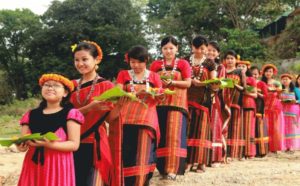Bangladesh is a small country but beautiful in nature! This country is full of wealth and manpower. Most of the number of Bangladeshi people are Muslim and some of others religions. So many tribes live in Bangladesh as well called indigenous peoples. They are the part of Bangladesh also.

TRIBES IN BANGLADESH AND LIFESTYLE [TRIBES IN BANGLADESH AND LIFESTYLE]
Chakma Tribe [Chakma Tribe]
The Chakmas are the largest ethnic group in the Chittagong Hill tracks, around 3 lac, making up more than half the tribal population. [The Chakmas are the largest ethnic group in the Chittagong Hill tracks, around 3 lac, making up more than half the tribal population.] Religion is Buddhism. [Religion is Buddhism.] The Chakmas are a people with their own culture, folklore, literature and traditions. [The Chakmas are a people with their own culture, folklore, literature and traditions.] Biju, the three day long festival is the main cultural festival of chakma people and marks the end of Bengali calendar. [Biju, the three day long festival is the main cultural festival of chakma people and marks the end of Bengali calendar.] It’s celebrated with singing, dancing, drinking and general merriment on the thirteenth of April every year.

Rakhaine Tribe
Since 1797 Rakhines are here and now they are a small aboriginal community of Bangladesh. The Rakhaine community inhabiting in the coastal areas of Patuakhali, Borguna and Cox’s Bazar migrated to Bangladesh from Myanmar about two hundred years ago. With hard work, they turned the uncultivable deep forest of the coastal belt into a habitable area. They are very being peace-loving people.
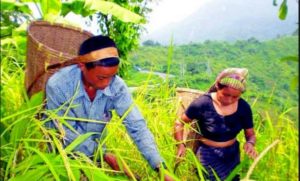
Marma Tribe
The Marma are the second largest ethnic minority group in Bangladesh. Most Marmas live in the three hill districts of Rangamati, Bandarban and Khagrachari. The headquarter of the Raja or Chef of the Marma society is located at Bandarban. Marmas speak an Araknese dialect and their language is written in Burmese characters. In recent times Marmas speak the corrupt language of Chittagong. Rice is their main food.
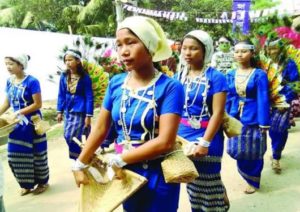
Saotal Tribe
Most of the Saotals live in Naogaon where they came 200 years ago. Saotals carry a historic move in the Malda and Dinajpur mutiny at 1902. Tevaga andolon at 1946-47, Natchol mutiny at 1947-50 leed by Ila Mitro.
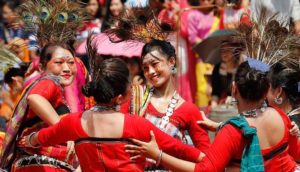
Tripura Tribe
Around 62 thousand Tripura live in Khagrachori, Ranganati, Bandarban, Chadpur, Sitakunda, Mirsorai, Sylhet, Hobiganj, Moulovibazar, Rajbari, Faridpur in Bangladesh. They came here from Tibet. Mostly they live in Khagrachori.
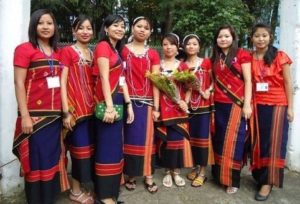
Garo Tribe
About 2 lac Garos are found in greater Mymensing and Gazipur, Ranpur, Sunamganj, Sylhet, Moulovibazar district of Bangladesh. Most of them are Christians and farmers. After getting married the man lives in his wife’s house. While the property of Garos are owned by the woman, the men folk govern the society and domestic affairs and manage the property.
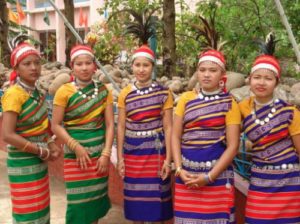
Manipuri Tribe
The Manipuris mostly live in Sylhet. Ras is the main festive in their lives. Moreover, they live in Hobigang, Moulovibazar, Sunamgang etc. Monipuri Dance is a popular dance here.
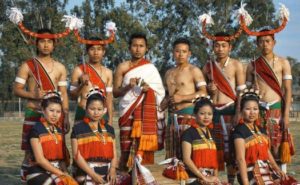
These are the top seven and famous tribes in Bangladesh. They lead their life with their own culture.
In Bangladesh, Survival of Indigenous Tribes Begins at School
A majority of the indigenous community remains illiterate and cannot keep pace with the fast development taking place in Bangladesh. At least 25 languages are spoken by the 54 indigenous communities of Bangladesh, where 80% of the indigenous peoples live in the plain land districts of the North and South-East of the country and the rest in the Chittagong Hill Tracts (CHT) area. The indigenous children in the plain lands are yet to get books in their own language.

In Bangladesh, there are about 48 different indigenous communities living in the plain lands (central north and northeast) and hill areas (southeast). Only 30 of these communities are on government records. Though they claim that their population is over 3 million. The government numbers are different. According to the National Census of 2011, the country’s indigenous population is around 1,586,141, which signifies 1.8% of the total population.

The ethnic tribes that make up 1-2% of the population in Bangladesh are scattered throughout the country, except in a few pockets where they are concentrated. The most prominent and conflict-ridden of those is the Chittagong Hill Tracts region (CHT) comprising Rangamati, Bandarban and Khagrachhari districts. Bangladesh is blessed with a rich cultural heritage. Bengali literature, music, dance and other art forms continue to enchant millions, Bengalis and others alike. But the cultural heritage of this country has similarly been enriched by the lifestyles and the literary and cultural traditions of other peoples as well, who are not ethno-linguistically Bengali. These are the indigenous peoples, who refer to themselves as Adibashi in Bengali (Adivasi in Hindi and Nepali).

BANGLADESH: THE PLIGHT OF THE INDIGENOUS PEOPLE
INDEGENOUS PEOPLE OF BANGLADESH AND THEIR RIGHTS
Bangladesh is home to more than 54 indigenous peoples who speak at least 35 languages, along with the majority of the Bengali population. Bangladesh has not adopted the United Nations Declaration on the Rights of Indigenous Peoples, and the economic and political rights of the country’s indigenous peoples continue to be ignored.
Tribal people of Bangladesh and their culture
- Chakma Tribe. The Chakma are the largest ethnic group in Bangladesh.
- Marma Tribe. The Marma are the 2nd largest indigenous ethnic group in Bangladesh.
- Tripura Tribe.
- Tanchangya Tribe.
- Khumi Tribe.
- Khiang Tribe.
- Bawm & Pankhu Tribe.

Bangladesh takes unusually longer time for resolution. Indigenous people, largely poor and illiterate, find it hard to hang on to the court case for long. Land grabbers seize the opportunity to put pressure on the helpless victims to sell their property. When the land grabbers fail in their techniques, they eventually go for harming (to the extent of killing even if necessary) their opponents. It has been seen that state actors are also not lagging behind non-state actors in seizing lands belonging to indigenous peoples.

Indigenous Peoples of Bangladesh – alive, struggling, fighting and uniting
The situation for Indigenous Peoples in Bangladesh in many ways echoes the situation of other Indigenous Peoples in Asia: they face heavy militarization; they are stigmatized as anti-national for wanting to be included in decisions affecting their lives – such as industrial development taking place on their ancestral lands, lands which they depend on for their livelihood; and their lands are grabbed at the speed of light, and with their land goes a huge part of their identity. Indigenous women are targeted, and rape is used systematically as a weapon to suppress them. The misery seems to be unending. Yet they are still here; alive, struggling, fighting, uniting.
Indigenous people in Bangladesh oppose resort on ancestral land
As a five-star hotel and amusement park are built in the Chittagong Hill Tracts, locals are fearful of losing water sources and say traditional livelihoods of 10,000 residents will be harmed. “The Bandarban Hill District Council is not the owner of the land leased to the resort or five-star hotel. How can they give this land to another institution for commercial purpose? It’s a complete violation of law.” Roy is also the traditional chief of the Chakma, an indigenous community in Bangladesh and India.

Calls to guarantee rights of small ethnic groups in Bangladesh
11 Major tribes of Bangladesh (ethnic/indigenous groups)
Protect the Indigenous Peoples in Bangladesh!
Bangladesh (/bæŋləˈdɛʃ/; Bengali: বাংলাদেশ, pronounced [ˈbaŋlaˌdeʃ] (listen)), officially the People’s Republic of Bangladesh, is a country in South Asia. It is the eighth-most populous country in the world, with a population exceeding 163 million people in an area of either 148,460 square kilometres (57,320 sq mi) or 147,570 square kilometres (56,980 sq mi), making it one of the most densely populated countries in the world. Bangladesh shares land borders with India to the west, north, and east, Myanmar to the southeast, and the Bay of Bengal to the south. It is narrowly separated from Nepal and Bhutan by the Siliguri Corridor; and from China by the Indian state of Sikkim in the north, respectively. Dhaka, the capital and largest city, is the nation’s economic, political, and cultural hub. Chittagong, the largest seaport, is the second-largest city.








